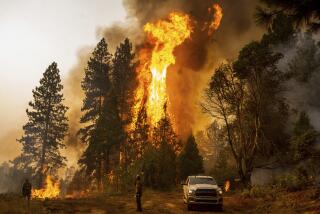Volcanic Eruptions Deplete Ozone Layer : Science: Study of Pinatubo blast strengthens views, including findings that Earth can be cooled temporarily.
- Share via
SAN FRANCISCO — Research on the effects of last year’s Mt. Pinatubo eruption in the Philippines has strengthened scientific views that such major volcanic events can lead to a temporary cooling of the Earth’s climate and contribute to depletion of the ozone layer.
At the same time, new findings suggest that the culprit in volcano-related cooling and ozone reduction is not primarily ash but sulfur and sulfate aerosols emitted into the stratosphere, as well as chlorine and other acidic compounds, according to more than a dozen papers presented at the annual meeting of the American Geophysical Union here this week.
Atmospheric tests showed that Pinatubo ash dropped rather quickly out of the upper atmosphere, but sulfur dioxide--eventually becoming small droplets of sulfuric acid--remains in the stratosphere.
The droplets condense in a mist of fine particles. These particles reflect the sun’s radiation, cooling the lower atmosphere. At the same time, the reflected radiation warms the upper atmosphere. The particles also interact chemically with the planet’s ozone shield, hastening its depletion.
Some research has also indicated that factors such as the shape of the volcanic plume and the location of the volcano can have important effects on an eruption’s worldwide influence.
In the case of the so-called Plinian column characteristic of the eruption of Mt. Vesuvius in AD 79, emissions jet out of a narrow vent to form a mushroom cloud and spread material farther than any other type of cloud. By contrast, co-ignimbrite columns spread emissions along the ground for much shorter distances. Emissions from volcanoes close to the Equator that have a Plinian column travel the farthest.
Ejected material from the Pinatubo eruption, the largest of the century, has reddened sunsets around the world by reflecting sunlight. Tests since the eruption have shown cooling averaging about 0.4 degrees Fahrenheit worldwide. One group from the National Aeronautics and Space Administration’s Langley Research Center found ozone decreases of 30% in certain areas.
A Russian scientist, P. Ya Groisman, said that while central Russia and Ukraine experienced a cool summer after Pinatubo, as the historical pattern after major eruptions indicated they would, a pattern of warmer winters after such events in western Russia also held.
The results have sent scientists searching through historic records for other major eruptions that have altered the world’s climate. The very cold summer of 1816, when snow fell on the U.S. East Coast in July, followed the 1815 Tambora eruption in the Indonesian Archipelago, and some records indicate that another major eruption (no one has been able to find where) caused wide similar effects in the AD 536.
Other studies reported here explored increases in atmospheric sulfur, nitrogen and chlorine believed to be related to Pinatubo that occurred as far away as Pasadena and Seattle.
Emissions from such a large eruption circle the globe. One of the puzzles of the Pinatubo explosions of June, 1991, is that many more times the sulfur seems to have been emitted than would be indicated by the total volume of ejected material.
Even assuming that much of the sulfur, chlorine and other emissions was in gaseous form, researchers have been unable to determine where all the sulfur came from. Some believe that it came from anhydrite crystals in a pumice that dissolves easily.
Satellite instruments detected 20 times the sulfur that was expected from the Pinatubo eruption, more than 20 million tons in all, and, in 1982, 100 times more than expected from the El Chichon eruption in Mexico. In 1980, Mt. St. Helens in Washington emitted little sulfur and had little climatic effect.






